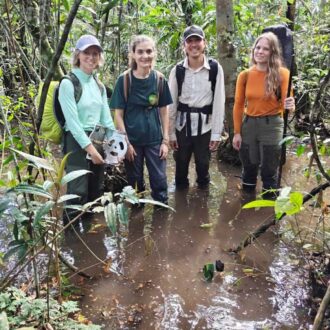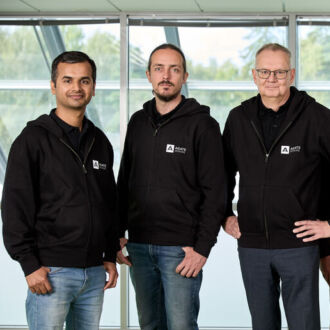At Helsinki’s state-of-the-art Vuosaari Harbour, opened in November 2008, a rep from one of the main operators takes us on a behind-the-scenes tour. Watch out for 12-metre spiders.
Our guided tour of the new Vuosaari Harbour outside of Helsinki is led by project manager Paavo Mäntylä from Finnsteve, the largest stevedoring (loading and unloading) company in the harbour. He has seen many harbours in the course of his career, having worked on ships and quays ever since he was still at school. The inauguration of a brand-new harbour in November 2008 was a milestone for him.
“The first day of the new harbour was a memorable one,” says Mäntylä. “We were thrown in at the deep end, since the previous day Helsinki had received its worst snowstorm in 40 years. We had to clear 70 hectares of 50-centimetre-deep snow. It was a huge effort, but we did it.”
Spiders with wheels
We drive off towards the Finnsteve loading and storage area – for safety reasons we’re not allowed to proceed on foot. As soon as we pass through the electronic access control gates we can see why. A pedestrian would be minuscule compared to the 12-metre gantry cranes, nicknamed “spiders”, and could easily be overlooked and crushed by their gigantic wheels.
The stringent safety regulations are also in place because the supervision and security systems of the new harbour are compliant with the International Ship and Port Facility Security Code (ISPS) and the Customs-Trade Partnership against Terrorism Cost/Benefit Survey (C-TPAT), which regulate how access to and movement within the security area must be monitored. All vehicles entering the area are recorded and their access permits verified.
“The harbour fulfils the requirements placed on security arrangements at the port of origin for shipments to the USA,” explains Mäntylä.
Fifteen-minute turnaround
We face a field full of stacked containers and lines of waiting lorries. Soon a crane resembling a stick insect approaches a lorry, picks up the container it is hauling and deposits it at a predetermined location. The entire logistics process is guided over wireless networks. Assuming that the documentation is in order, a lorry driver can make a 15-minute turnaround at the harbour.
“The harbour works so well because the processes are so well planned and goods and vehicles move smoothly,” says Mäntylä. “Although the area is large, its storage capacity is nevertheless limited compared with the volume of goods that can be handled.”
State-of-the-art lifting
The quayside is shaped in the form of two large artificial headlands framing a harbour basin. The larger of these is held entirely by Finnsteve. The company’s quays can accommodate four container ships and ten ro-ro ships at a time. For every container ship berth there is a state-of-the-art container crane that can lift two containers at once, allowing the processing of 25 to 35 containers per hour. That crane, 68 metres tall at its full height, places its burden on the ground where it is picked up by a gantry crane and taken to await further transport and processing. Unloading and loading a large container ship or ro-ro ship takes from 12 to 16 hours. The harbour can process ships around the clock if necessary.
The pride of the ro-ro berths are the two twin-level ramps that allow large vessels to be loaded and unloaded on two decks at once.
Heavy work in good conditions
Goods are packed swiftly at a terminal where containers are placed on the outside with their open ends pointing in. A rail line extends to the inside of the terminal hall so that trains can bring their goods – forestry products, for example – directly to the terminal to be loaded into containers and shipped away. The premises are spacious and practical.
“The facilities here are worlds away from what we had in Länsisatama and Sompasaari [former harbours closer to downtown Helsinki],” says Mäntylä. “We have excellent staff facilities and services, including a canteen, a gym and health care. And, of course, there are four saunas where you can wash up after your working day.”
By Salla Korpela, September 2009



